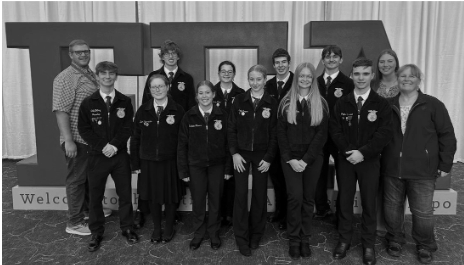Why GMOs are safe, healthy; Misinformation, myths disproved
December 15, 2022
Centerforfoodsafety.org falsely claims that Genetically Modified Organisms (GMOs) are unregulated and unhealthy. Why would scientists create GMOs if there were no benefits to them?
This website explains how GMOs have “been genetically altered so that it can withstand more pesticides or produce its own.” While this is true, a Harvard study explains how crops that produce their own pesticides are significantly safer than synthetic pesticides.
Websites with misinformation shroud the facts from the U.S. Federal Drug Association (FDA) and scientists alike. In a recent poll, 47% of North Harford students said they do not trust GMOs. “The U.S. FDA, U.S. Environmental Protection Agency (EPA), and U.S. Department of Agriculture (USDA) ensure that GMOs are safe for human, plant, and animal health,” according to the FDA. “FDA’s voluntary Plant Biotechnology Consultation Program evaluates the safety of food from new GMOs before they enter the market.”
Biochemists Herbert Boyer and Standley Cohen made the first GMOs in 1973 by inserting DNA from one bacteria into another, according to the FDA. About twenty years later, GMOs were being used to improve the foods we eat and make them last longer. “In 1994, the transgenic ‘Flavour Saver tomato’ was approved by the FDA for marketing in the USA. The modification allowed the tomato to delay ripening after picking.” The U.S. National Institute of Health explains. “In 1995, few transgenic crops received marketing approval.”
Another accusation against GMOs is that they cause allergic reactions. In 2000, “a California woman named Grace Booth went into anaphylactic shock after eating three corn tacos,” according to Harvard University biologist Charles Xu. The allergic reaction came from a protein in the corn, Cry9C, which was used to make the tortillas. “The StarLink corn had only been approved for animal feeding and was never intended for human consumption because of concerns that Cry9C would be difficult to digest and cause an allergic reaction,” the article states. “However, it still entered the human supply due to cross-pollination when the GMO corn was planted too close to unmodified crops.” This incident led to people doubting the safety of GMOs.
However, “If you are allergic to foods made with traditional (non-GMO) soy, you will be allergic to foods made with GMO soy,” the FDA explains. “If you’re not allergic to foods made with traditional soy, you won’t be allergic to foods made with GMO soy.” Booth had a reaction to the unapproved protein, which she would not have known because it is not intended for human consumption.
The last common argument against GMOs is how it loses nutritional value. This is false. Studies at the FDA show “GMOs are as safe and nutritious as their non-GMO counterparts and that GMOs do not affect our health any differently than non-GMOs.” In fact, some GMOs provide greater nutritional value. High oleic crops such as soybeans are “a GMO crop that delivers oil with lower saturated fat than conventional soybean oil and contributes no trans fats to products,” according to Hungry for Truth.
Senior Kaitlyn Oswald does not trust GMOs “because they basically alter the DNA,” she says. “It doesn’t seem natural to me.”
On the other hand, senior Riley Stewart trusts them. “They were created by scientists to provide more nutritional value to consumers,” she explains. “Also, I did some research in a Bio class, and genetically modifying something really solely focuses on manipulating the genome of the organism, so I feel like I trust that level of science.”
GMOs have been around for decades. “GMO has become a hot word. In today’s GMOs, we have carefully constructed vetting processes that examine the modified genes (usually via the FDA),” a biology major at the University of North Texas, Matthew Wallace, says. “Additionally, I work to genetically modify organisms for the purpose of making biofuels and bioplastics. Point being: we do not eat every GMO that we modify–plants help us out more than just food.”











